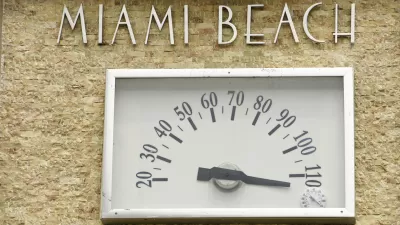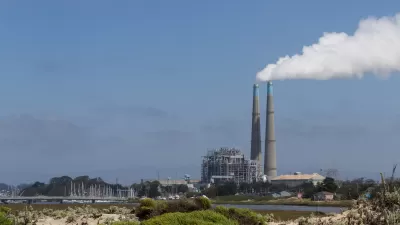The Biden Administration announced the second massive investment of federal funds for coastal resilience on June 6. The Inflation Reduction Act allocated $3.3 billion to NOAA. In March, the Infrastructure Investment & Jobs Act added $562 billion.

The National Oceanic and Atmospheric Administration (NOAA), a bureau within the U.S. Department of Commerce, is a major beneficiary of the Biden Administration's two signature climate, energy, and infrastructure laws that can easily be confused with each other.
On June 6, the “Commerce Department announced it will put $2.6 billion toward coastal climate resilience in funds from the Inflation Reduction Act (IRA),” reported Zack Budryk, who covers energy and environmental issues for The Hill.
The funds are part of $3.3 billion allocated to NOAA by the IRA. The Biden administration previously allocated about $562 million in coastal climate resilience in April through the Bipartisan Infrastructure Law [aka Infrastructure Investment and Jobs Act or IIJA].
Related in Planetizen:
- 'Inflation Reduction Act' a Mixed Bag for Climate Action, Planning Innovation, August 1, 2022
- Key Details of the $1.2 Trillion Federal Infrastructure Bill, November 15, 2021
“Under President Biden’s leadership, we are making the most significant direct investment in climate resilience in the nation’s history,” said U.S. Secretary of Commerce Gina Raimondo in the NOAA press release.
The historic $2.6 billion investment in climate resilience and coastal communities will help ensure communities, especially Tribes and vulnerable populations, have the resources and support needed to prepare, adapt and build resilience to weather and climate events as well as strengthen workforce development, marine resources, nature-based solutions, conservation, regional partnerships and Tribal priorities.
Biden joins the action
The president himself took the opportunity during a three-day trip to California to announce NOAA's newest program, the Climate Resilience Regional Challenge made possible by the aforementioned IRA investment.
“Standing in front of salt marshes at the edge of the San Francisco Bay on Monday, President Biden announced $600 million in funding for coastal communities building projects to protect against the impacts of climate change, as well as $2.3 billion to bolster electric grid resilience,” reported Danielle Echeverria for the San Francisco Chronicle on June 19.
Joined by Gov. Gavin Newsom, Peninsula congresswoman Anna Eshoo, Santa Clara County and Palo Alto elected officials and local activists at the Lucy Evans Baylands Nature Interpretive Center in Palo Alto, Biden said that the funding was part of his administration’s focus on “aggressive climate action” amid the devastating impacts of climate change, including wildfires, drought and floods in California.
“The Challenge is the first and largest funding opportunity released under the $2.6 billion Inflation Reduction Act climate resilience framework that the Department unveiled earlier this month,” according to NOAA's announcement on June 20.
The power grid resilience funding from the Infrastructure Investment and Jobs Act (IIJA) was announced by the U.S. Department of Energy last July.
Distinguishing the IRA and IIJA
What's notable about the climate resilience investments is that they focus largely on climate adaptation rather than mitigation of emissions. It was that focus that helped the IIJA to receive the support of 19 GOP senators on August 10, 2021, led in part by Sen. Bill Cassidy of Louisiana, enabling it to pass a Senate filibuster.
The IRA, on the other hand, bypassed the filibuster as a reconciliation bill on Aug. 7, 2022, receiving no GOP votes in either house. It remains a GOP target for repeal.
FULL STORY: Biden administration announces $2.6 billion toward coastal climate resilience

Alabama: Trump Terminates Settlements for Black Communities Harmed By Raw Sewage
Trump deemed the landmark civil rights agreement “illegal DEI and environmental justice policy.”

Study: Maui’s Plan to Convert Vacation Rentals to Long-Term Housing Could Cause Nearly $1 Billion Economic Loss
The plan would reduce visitor accommodation by 25% resulting in 1,900 jobs lost.

Why Should We Subsidize Public Transportation?
Many public transit agencies face financial stress due to rising costs, declining fare revenue, and declining subsidies. Transit advocates must provide a strong business case for increasing public transit funding.

Paris Bike Boom Leads to Steep Drop in Air Pollution
The French city’s air quality has improved dramatically in the past 20 years, coinciding with a growth in cycling.

Why Housing Costs More to Build in California Than in Texas
Hard costs like labor and materials combined with ‘soft’ costs such as permitting make building in the San Francisco Bay Area almost three times as costly as in Texas cities.

San Diego County Sees a Rise in Urban Coyotes
San Diego County experiences a rise in urban coyotes, as sightings become prevalent throughout its urban neighbourhoods and surrounding areas.
Urban Design for Planners 1: Software Tools
This six-course series explores essential urban design concepts using open source software and equips planners with the tools they need to participate fully in the urban design process.
Planning for Universal Design
Learn the tools for implementing Universal Design in planning regulations.
Smith Gee Studio
Alamo Area Metropolitan Planning Organization
City of Santa Clarita
Institute for Housing and Urban Development Studies (IHS)
City of Grandview
Harvard GSD Executive Education
Toledo-Lucas County Plan Commissions
Salt Lake City
NYU Wagner Graduate School of Public Service





























